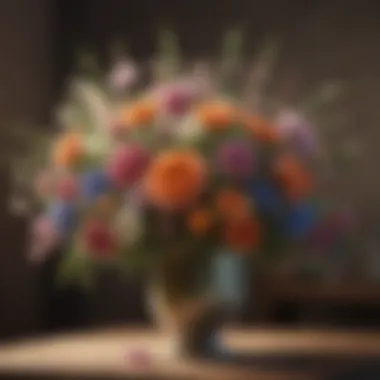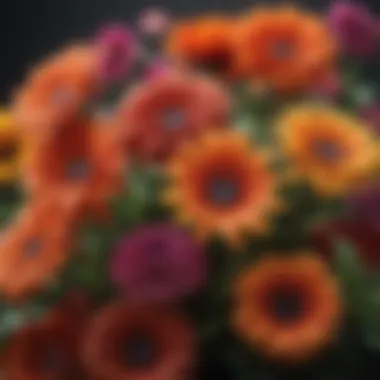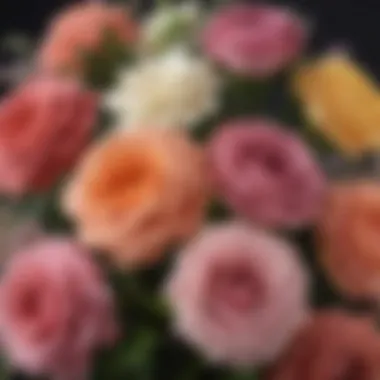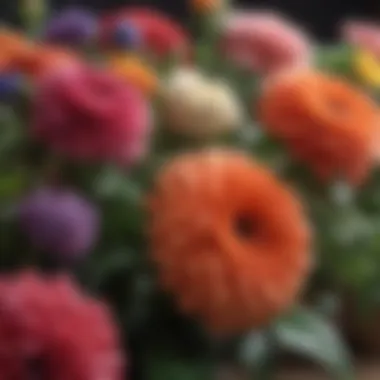Understanding Flower Bouquet Costs: A Comprehensive Guide


Intro
Flower bouquets serve as classic symbols of appreciation, love, and life's milestones. Understanding the cost of these beautiful arrangements is crucial for those purchasing them. Many factors influence the price of flower bouquets, making it imperative to navigate this landscape effectively. Terrain varies by the size of the bouquet, choice of flower types, and their availability by season. This guide aims to decrypt the complexities of bouquet pricing, equipping consumers with valuable insights to manage their budgets efficiently.
Flower Bouquet Cost Factors
To grasp the dynamics of flower bouquet costs, it is essential to acknowledge various elements at play. Some of the most significant aspects include size, flower type, seasonality, and location. Each element adds layers to the final price, which significantly varies among different vendors. By dissecting these factors, one can make strategic choices that align both with personal desires and financial considerations.
Size of the Bouquet
The size of your bouquet is one of the biggest factors impacting its price. Bouquets range from small, modest arrangements to elaborate centerpieces. Larger bouquets typically use more flowers, which translates to higher overall costs. Whether it is a bridal bouquet or a simple gift to a friend, understanding your needs can streamline costs effectively.
Types of Flowers
The flowers selected in a bouquet greatly influence the cost. Exotic blooms like orchids or peonies come at a premium, while common flowers like daisies and sunflowers offer economical options. Flower qualities like durability and fragrance play roles as well. Prices may fluctuate based on trends and consumer demand, making it helpful to stay informed about popular varieties.
Seasonal Availability
The cost of flowers significantly varies depending on their regional availability. Purchasing blooms out of season typically incurs higher prices due to extra transportation and handling costs. Many flower shops offer seasonal bouquets as their rates can be more budget friendly and eco-conscious. Consumers should stay alert to what's current in their vicinity to optimize flower shopping.
Geographic Location
Where you buy your flowers impacts their pricing. Urban areas usually present higher costs as shops deal with increased overhead expenses. Conversely, buying directly from local farms or during farmers' markets can yield better deals. Being aware of local trends can inform well-considered purchases.
Understanding these cost factors creates powerful tools for better choices in floral arrangements.
Closure
By weighing these core considerations, individuals can navigate the complexities of flower bouquet costs with greater knowledge. This enhancement promotes not just better financial decisions but elevates the enjoyment of gifting and receiving flowers in all aspects of life.
Prelude to Flower Bouquet Pricing
Understanding the various costs associated with flower bouquets is essential for anyone looking to purchase floral arrangements. The intricacy of pricing may seem daunting at first glance, but being informed can make significant difference when making a decision.
Flower bouquet pricing can vary widely based on numerous factors. Realizing these factors helps prospective buyers set their expectations and budget appropriately. Exploring the complexities of how arrangements are priced yields insight into not just what influences the price but also why certain bouquets are more expensive than others.
Additionally, this understanding allows buyers to appreciate the artistry and work involved in floral arrangements. Your chosen bouquet might seem extravagant or simple, but the historical convergence of selection and cultivation helps define its value.
In a world where flowers play a crucial role in celebrations, curses, or daily joy, knowledge of their cost enables better procurement techniques. Families planning events or young professionals considering gifts can significantly benefit from this guide, ensuring they make decisions that are not only satisfying but also aligned with their financial priorities.
This article promises to break down all of these complexities around flower bouquet pricing, making the process of selecting the right flowers more manageable and enjoyable for everyone involved. Through analyzing aspects from flower types to the importance of seasonality, we hope to guide you in achieving a balance of value and meaning in your floral purchases.
Factors Influencing Flower Bouquet Costs
Understanding the factors that influence flower bouquet costs is pivotal for consumers who wish to make informed decisions. These elements affect pricing significantly and can vary across different suppliers and regions. By examining the key elements such as flower types used, the size and complexity of bouquets, seasonal availability, and market variations, individuals can identify the best options for their needs. This analysis not only enhances budget management but also ensures that buyers receive the best value for their purchases.
Types of Flowers Used
The selection of flowers utilized in a bouquet directly impacts its cost. Certain varieties, like roses and orchids, are often on the higher price spectrum due to their perceived value and the meticulous cultivation they require. Meanwhile, more commonly found blooms such as daisies or chrysanthemums tend to be more affordable.
In addition to individual flower cost, the combination of flowers can also lead to variations in pricing. For instance, when a bouquet contains rare flowers or a diverse mix of popular species, this can escalate overall costs, given the sourcing challenges and breeding requirements. Buyers should consider not only the aesthetic appeal of flower types but also the associated price changes.
Bouquet Size and Complexity
Bouquet size is a significant factor in determining cost. Larger bouquets require more flowers, which results in increased material expenses. For instance, a small hand-tied arrangement may only cost a fraction of what a lavish centerpiece or bridal bouquet would command.
Also, the complexity of the design plays a huge role. Simple arrangements are likely to be cheaper while intricate designs with elaborate wrapping in superior materials interpret more work. It often requires specialized skills, especially for wedding designs or artistic creations, which can further enhance the pricing. Understanding these elements allows buyers to gauge their options better.


Seasonal Availability
Availability can affect costs significantly. Flowers that are out of season may incur higher prices due to the need for importation or specialized growing conditions. For example, peonies, which bloom in late spring, can be relatively affordable in their season. However, attempting to acquire them during winter would lead to inflated prices due to scarcity.
Moreover, buying in another growing season sometimes causes unwelcome costs for consumers. By acclimatizing with the seasons, individuals can capitalize on more affordable blooms, optimizing both cost and freshness.
Location and Market Variation
Geographic location can influence where buyers see significant differences in bouquet pricing. Urban centers such as New York City typically exhibit higher prices due to increased operational costs, from rent to labor. Conversely, rural areas may present lower pricing simply due to lower overhead.
Additionally, local flower markets can provide fresh-cut blooms at competitive prices. The saturation of suppliers in a market may create opportunities for bargain pricing too. Understanding this regional variety informs better choices when selecting a supplier or store, ultimately leading to cost-effective purchases.
Maintaining awareness in each of these factors fosters better decision-making during flower bouquet purchases. By evaluating the types of flowers, exposure to seasonal availability, assessing sizes based on need, and understanding local pricing implications, consumers may secure favorable arrangements more efficiently.
Average Cost of Flower Bouquets
Understanding the average cost of flower bouquets is essential for making informed choices when buying flowers. It offers a baseline that potential buyers can reference when exploring their options. Knowing the average price range helps one to set a budget and understand what features might come with different price points. This analysis breaks down the categories clearly, providing insights that illuminate both the benefits and considerations relevant to purchasing floral arrangements.
Low-End Bouquets
Low-end bouquets typically range from budget-friendly prices, usually around $20 to $40. These arrangements can feature seasonal and commonly available flowers. Common selections might include daisies, carnations, or sunflowers. Importance of this section lies in providing blossoming options for individuals on a budget. While these arrangements might not have luxury flowers, they can still achieve visual appeal and are suitable for casual gifting or home decoration. Many discounted florists, grocery stores, or online marketplaces offer affordable choices for simpler needs.
Key Considerations:
- Simplicity: Designs are often minimal and made up of a fewer number of stems.
- Availability: Use of locally available flowers are common which reduces transport costs.
- Duration: These bouquets typically have a shorter lifespan.
Mid-Range Bouquets
Mid-range bouquets present more vibrant and diverse options, falling into the price range of $40 to $100. These arrangements usually feature a greater variety of flowers, such as peonies, lilies, or ranunculus. Buyers can find floral designs that carry more intricacy without straining their finances too much. This section is vital to recognize for anyone who desires quality, as these bouquets can add balance between costs and spectacular designs.
Key Considerations:
- Quality: Freshness and quality could be superior compared to low-end options.
- Design Complexity: More color and texture variation in arrangements.
- Occasions: Suitable for birthdays or intimate gatherings without breaking the bank.
High-End Bouquets
High-end bouquets often describe lavish arrangements that can exceed $100 and more. These Mariage floral delights usually incorporate premium flowers, such as orchids, gardenias, or rare blooms, exclusively available to trained florists. The significance of this category is apparent for special occasions, likely weddings or significant milestones where statement pieces and luxurious details are needed.
Key Considerations:
- Exclusivity: Unique flowers that enhance visual and aromatic qualities.
- Artisan Workmanship: High-end florists emphasize the importance of skilled composition.
- ** Occasion Specific:** Perfect for important events, formal services, and personal celebrations.
Overall, understanding the average cost of flower bouquets assists buyers in aligning their spending choices with their floral needs. Buyers should be aware that the actual cost may vary based on crafting fees and specific retailers, but this breakdown serves as guiding knowledge.
Understanding Retail Markup
Understanding the retail markup on flower bouquets is crucial for buyers who wish to navigate the floral market effectively. This section will cover several dimensions involving markup, such as wholesale and retail pricing, as well as the related fees from floral designers. Each element plays a significant role in the final price that consumers see at purchase.
Wholesale vs.
Retail Pricing
Wholesale prices refer to the costs that florists pay to growers or wholesalers for flowers. This price is usually much lower than what the final consumer pays. When florists acquire stock, they expect to mark it up for several reasons. They need to cover operational costs alongside making a profit. Therefore, it’s typical for a florist to apply a markup that can range from 2 to 3 times the wholesale price.
Here are a few key considerations:*
- Quality of Flowers: Wholesale purchases enable access to fresh and high-quality blooms. This very concept underlines the premium that might be seen in retail prices.
- Operational Costs: Florists deal woth rent, utilities, and staffing. Each of these necessary business expenses is considered when setting retail prices.
- Market Demand: The popularity of specific flower varieties may drive costs higher in retail settings.
Understanding the difference between wholesale and retail pricing can help buyers realize that retail prices do not solely reflect the actual cost of flowers. There are numerous business-related expenses tied into this equation.


Floral Designer Fees
Floral designer fees are an additional cost that consumers need to take into account when considering bouquet prices. Designers put time and thought into creating arrangements that are visually appealing.remove how easy Highlights of these fees include:
- Expertise and Creativity: Designers possess a skill set developed over years. Their expertise adds both aesthetic value and innovation to every bouquet they create.
- Time Investment: Creating a custom bouquet demands a thoughtful approach and unrushed crafting. Consumers pay for the time and labor involved.
- Customized Solutions: Unique requests—like specific flower selections, colors, or styles—will inevitably lead to increased costs, reflecting the tailored nature of the design.
Floral designer fees can represent a significant portion of the total bouquet cost, emphasizing that artistry is valued alongside the flowers themselves.
This understanding grounds consumers in the reality of pricing while allowing them to make better choices. Grasping these concepts enables individuals to appreciate the art of flower bouquet creation more deeply.
Ultimately, this phase presents a glimpse behind the scenes and contextualizes why costs fluctuate between various sellers.
Buying Directly from Growers
Buying flowers directly from growers has advanced importance in the aspect of flower bouquet costs. This approach allows consumers to engage with the source. Understanding the essence of this practice helps people make educated choices. Purchasing directly cuts out the intermediaries, leading to both practical and economical advantages.
This method often leads to fresher flowers. Local growers tend to offer a wider selection along with organic options. Direct purchases can ensure significant quality since consumers access the flowers quicker from farm to vase.
Another key component of buying from growers is sustainability. Supporting local farmers promotes sustainable practices in floriculture. This approach carries positive social implications, helping local economies thrive.
Benefits of Direct Purchasing
When consumers buy directly from growers, numerous benefits emerge:
- Fresher Florals: Direct purchasing often guarantees the flowers are recently harvested. It allows individuals to gain a catchy assortment with preserved freshness.
- Personal Relationships: Building rapport with local growers opens the possibility for customization and exclusive offers. Elsewhere, this may not be achievable.
- Education: Interactions with growers can offer insight into cultivation methods, flower types, and bouquet design. Such knowledge provides deeper appreciation for floral arrangements.
Potential Cost Savings
Purchasing from growers can substantially reduce costs, depending on various factors:
- Elimination of Middlemen: Avoiding distributors means lower prices that match soon-to-harvest pricing.
- Bulk Purchasing Options: Growers often offer significant discounts on bulk orders. This option can be perfect for events.
- Seasonal Promotions: Specific times of year may yield special offers for certain flowers.
The direct purchaser can ultimately achieve more value while enjoying superior quality with this approach. Investing in floriculture directly is beneficial, both in terms of quality and cost efficiency.
Online vs.
In-Store Purchases
Choosing between online and in-store purchases is essential when looking at flower bouquet costs. This decision affects various factors. They include convenience, price variances, and potential additional fees. Understanding these aspects helps consumers make informed choices aligning with their needs.
Convenience of Online Orders
Online shopping offers a level of convenience that in-store experiences struggles to match. Notable aspects include:
- Time-saving: The ability to browse a wide selection from home eliminates the need for travel. This allows buyers to find exactly what they want quickly. Online platforms often offer the 24/7 availability that a physical store may not.
- Wide Selection: Online, you can explore numerous florists, compared to a single store at a time. This range enhances access to rare or specialized bouquets.
- Ease of Price Comparison: Simply click and compare prices across different websites. This enables customers to find the best deal more efficiently. You can also read customer reviews, providing insights into the bouquet quality.
However, one must be aware of potential drawbacks. For example, consumers can't physically touch or smell the flowers before purchase.
In-Store Experience and Costs
Purchasing from a physical store offers experiences that online cannot replicate. However, entering a store can lead to higher costs for several reasons:
- Immediate Assessment: Customers can see and touch the flowers in person, directly evaluating freshness. This aspect may warrant no risk of receiving a subpar bouquet.
- Personal Interaction: Engaging with staff can lead to custom advice tailored to buyers’ preferences. Florists may suggest suitable flowers or arrangements based on your interests.
- Additional Costs: Traditional stores entail higher expenses. These include rent, utility, and worker salaries, which could lead to inflated prices for consumers.
Though sometimes pricier, a supermarket may have its own floral section. This option provides budget-friendly bouquets yet with limited quality assurance compared to specialized shops.
Delivery Costs: An Added Expense


When purchasing flower bouquets, many buyers focus on the price of the flowers themselves. However, delivery costs must not be overlooked, as they can substantially add to the overall expense. Understanding the nuances of delivery fees assists in budgeting for floral purchases, be it for special occasions or day-to-day gifts.
Delivery fees can depend on various factors, including the distance between the florist and the delivery location, the size of the order, and additional services. Recognizing these components helps customers make more introspective decisions.
Local Delivery Fees
Local delivery fees refer to the costs that arise when bouquets are delivered within a specific vicinity of the florist. Buyers may often find these costs reasonable or even subsidized, especially within chosen service areas.
Many florists establish set fees for local deliveries, which typically fall within the range of $10 to $25. Different factors play a role in the determination of these fees, including:
- Distance from the Shop: Florists need to compensate for travel time and expenses. Therefore, a delivery fee may increase with distance.
- Time Sensitivity: If customers request same-day delivery, fees may surge to reflect expeditions in service delivery.
- Delivery Time Slot: Some require delivery in early morning or late night, which can also incur additional costs.
Additionally, it is critical to inquire about tracking options. This can increase buyer confidence as they can monitor their floral gift until it arrives.
Long-Distance Shipping Charges
For customers individuals vastu to more far-off destinations, long-distance shipping charges become relevant. These costs go beyond mere delivery; it necessitates careful handling to preserve the quality of flowers.
Factors directly influencing long-distance shipping costs generally include:
- Packaging Materials: Good packaging protects the flowers. It is essential in ensuring they remain fresh during transit, but it also raises handling costs.
- Shipping Timeframes: Speed of shipment can dramatically affect cost; opting for quicker methods increase prices.
- Delivery Preferences and Services: Some buyers wish for temperature-controlled services to maintain freshness over long hauls, specifically for peculiar flower types.
Understanding these costs allows educated conversations about selections when buying bouquets.
“Price is what you pay. Value is what you get.” - Warren Buffett
Managing expectations regarding delivery costs benefits the overall purchasing experience. As delivery options expand with technology and the market precises price contributions, comprehending them is vital.*
Custom Bouquets: Personalization and Cost
Custom bouquets hold a distinct appeal in the world of floral arrangements. They offer uniqueness and a level of personalization that can elevate the experience of giving or receiving flowers. Understanding custom bouquets is essential, especially for individuals looking to create something that truly represents their feelings or a particular occasion. The cost associated with custom bouquets varies and deserves attention to ensure informed decision-making.
Benefits of Customization
Custom bouquets allow for tailored selections that reflect personal taste and the intentions behind the gift. Here are some of the key advantages:
- Personal Touch: A specially made bouquet can evoke emotions and memories, making it memorable.
- Perfect Fit: Buyers can choose flowers that align with the recipient's preferences, situations, or even color schemes.
- Unique Creations: Most arrangements resonate well at events like weddings or anniversaries, where specific themes or meanings are crucial.
- Exclusivity: Customization imparts a sense of pride, knowing that one’s bouquet is unlike any other.
Custom bouquets offer a canvas for self-expression. The flowers become carriers of personal messages.
Cost Considerations for Custom Orders
Deciding on a custom bouquet involves multiple financial elements. The following aspects typically affect the price:
- Flower Selection: Premium flowers such as peonies or orchids are more expensive than common varieties. Costs can fluctuate based on brand and seasonal availability.
- Size of Bouquet: A larger bouquet naturally incurs a higher cost due to more flowers being used. Whether selecting a simple arrangement or seeking something more elaborate can drastically affect the final price.
- Design Complexity: Special designs may require additional flower types, making both time and skill necessary, which further drives up pricing.
- Delivery Costs: If ordering online or if a local florist includes delivery in their services, consider how that affects the overall expenditure.
Understanding these elements helps in estimating a budget before placing an order.
But preparing a personalized bouquet doesn’t just mean raising the costs; it also ensures a creation that tells a story—the essence of flowers beautifully arranged according to one’s imagination and needs.
Epilogue: Making Informed Decisions
In navigating the complexities of flower bouquet costs, it is crucial to arm oneself with knowledge. This article has detailed various factors influencing prices, providing a comprehensive guide that should inform purchasing decisions.
Understanding the details around bouquet composition, such as flower types and seasonal availability, offers transparency regarding pricing. Individuals can ascertain the significance of each component in the overall cost structure. Variations in location also play a pivotal role; recipients may favor sourcing bouquests from local vendors rather than large chains, facilitating a balance between freshness and affordability.
It is important to not only consider immediate cost but also the long-term implications. Custom bouquets enhance personal sentiments but carry additional financial responsibility. Hence, evaluating the budget before opting for tailor-made arrangements is advisable.
Here are some benefits of making informed decisions in this context:
- Cost Savings: Understanding regional market differences can lower expenses, ensuring you do not overspend.
- Better Quality: Learning about the best seasons for specific flowers helps achieve higher quality bouquets at reasonable rates.
- Enhanced Experience: Knowledge empowers choices that reflect personal or familial events, enhancing overall satisfaction with purchases.
"Knowledge is power; the more you know about costs, the better decisions you make."







